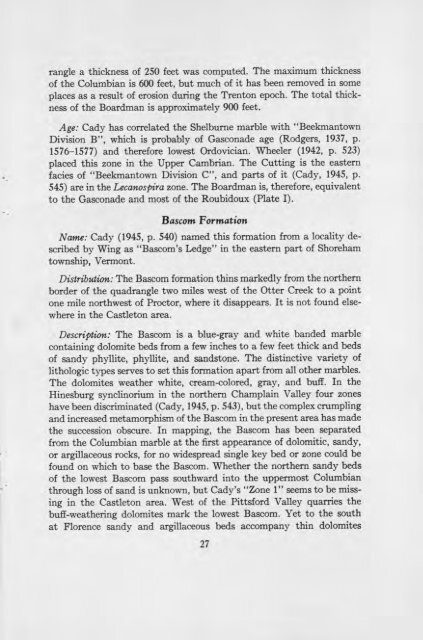STRATIGRAPHY AND STRUCTURE CASTLETON AREA VERMONT
STRATIGRAPHY AND STRUCTURE CASTLETON AREA VERMONT
STRATIGRAPHY AND STRUCTURE CASTLETON AREA VERMONT
Create successful ePaper yourself
Turn your PDF publications into a flip-book with our unique Google optimized e-Paper software.
angle a thickness of 230 feet was computed. The maximum thickness<br />
of the Columbian is 600 feet, but much of it has been removed in some<br />
places as a result of erosion during the Trenton epoch. The total thickness<br />
of the Boardman is approximately 900 feet.<br />
Age: Cady has correlated the Shelburne marble with "Beekmantown<br />
Division B", which is probably of Gasconade age (Rodgers, 1937, p.<br />
1376-1577) and therefore lowest Ordovician. Wheeler (1942, P. 523)<br />
placed this zone in the Upper Cambrian. The Cutting is the eastern<br />
facies of "Beekmantown Division C", and parts of it (Cady, 1945, p.<br />
545) are in the Lecanospira zone. The Boardman is, therefore, equivalent<br />
to the Gasconade and most of the Roubidoux (Plate I).<br />
Bascom Formation<br />
Name: Cady (1945, p. 540) named this formation from a locality described<br />
by Wing as "Bascom's Ledge" in the eastern part of Shoreham<br />
township, Vermont.<br />
Distribution: The Bascom formation thins markedly from the northern<br />
border of the quadrangle two miles west of the Otter Creek to a point<br />
one mile northwest of Proctor, where it disappears. It is not found elsewhere<br />
in the Castleton area.<br />
Description: The Bascom is a blue-gray and white banded marble<br />
containing dolomite beds from a few inches to a few feet thick and beds<br />
of sandy phyllite, phyllite, and sandstone. The distinctive variety of<br />
lithologic types serves to set this formation apart from all other marbles.<br />
The dolomites weather white, cream-colored, gray, and buff. In the<br />
Hinesburg synclinorium in the northern Champlain Valley four zones<br />
have been discriminated (Cady, 1945, p. 543), but the complex crumpling<br />
and increased metamorphism of the Bascom in the present area has made<br />
the succession obscure. In mapping, the Bascom has been separated<br />
from the Columbian marble at the first appearance of dolomitic, sandy,<br />
or argillaceous rocks, for no widespread single key bed or zone could be<br />
found on which to base the Bascom. Whether the northern sandy beds<br />
of the lowest Bascom pass southward into the uppermost Columbian<br />
through loss of sand is unknown, but Cady's "Zone 1" seems to be missing<br />
in the Castleton area. West of the Pittsford Valley quarries the<br />
buff-weathering dolomites mark the lowest Bascom. Yet to the south<br />
at Florence sandy and argillaceous beds accompany thin dolomites<br />
27













